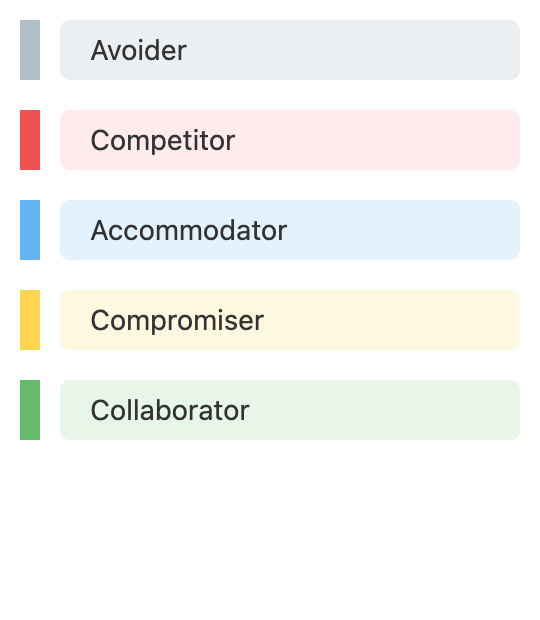When conflict happens, it’s easy to focus on what others are doing. But your own reactions, words, and body language play a big part in how things turn out. Everyone has their own way of handling disagreements—some people speak up right away, others go quiet, and many do a bit of both. These habits usually come from past experiences and can shape whether a conflict gets solved or just gets worse.
Most people have a “go-to” way of dealing with conflict:

- The Avoider: You might change the subject, leave the room, or stay quiet when things get tense. This can keep the peace for a while, but problems usually stick around and can get bigger over time.
- The Competitor: You want to win the argument and prove you’re right. This can help make quick decisions, but it can also hurt relationships and make others feel shut down.
- The Accommodator: You say things like, “Whatever you want,” even if you don’t agree. This keeps things smooth in the moment, but you might end up feeling frustrated or ignored.
- The Compromiser: You try to meet in the middle, so everyone gives up a little. This can work, but sometimes nobody gets what they really need.
- The Collaborator: You look for solutions that work for everyone, asking, “How can we solve this together?” This takes more time, but it often leads to the best results.
You might use different styles in different situations, for example maybe you avoid conflict at home but compete at work. The important thing is to notice your habits. No style is perfect for every situation. When you know your default, you can decide if it’s helping or if you want to try something different.
It’s not just what you say, but how and when you say it. Communication happens through three channels: what you say (verbal), how you say it (paraverbal), and your body language (nonverbal). This is called the Three Channels of Communication:
- Verbal: The actual words you use. For example, saying, “Can we talk about this?”
- Paraverbal: Your tone, volume, and speed. The same words can sound friendly or angry depending on your tone of voice.
- Nonverbal: Your body language, facial expressions, and gestures. Even if your words are polite, crossed arms or rolling your eyes can send a different message.
Even in emails or texts, your words (verbal) can come across as cold or caring, depending on your choice of words and punctuation.
Timing matters too. If you bring up a problem when someone is busy or upset, they might react badly, even if your point is fair. Waiting too long to talk about something can also make people feel blindsided. Try to pick a time when you both can focus and talk calmly.
Your first reaction in a conflict can set the tone for the whole conversation. If someone gives you feedback, do you get defensive right away, or do you pause and ask questions? Your body language—like crossing your arms, rolling your eyes, or looking at your phone—can make people feel shut out or disrespected. Small things like nodding, making eye contact, or saying, “I hear you,” can help others feel safe to talk.
Over time, people remember how you handle conflict. If you usually get defensive or raise your voice, others might avoid bringing up problems with you. If you stay calm and listen—using all three channels to show respect and openness—people will trust you more and come to you sooner, before things get out of hand.
Once you know your style and how you come across, you can start making choices that help everyone feel heard and respected. When you feel yourself getting defensive, try to pause and take a breath. Instead of jumping in to defend yourself, you can say, “I can see why you’d feel that way,” or, “That’s a good point.” This doesn’t mean you have to agree—it just shows you’re listening.
If you make a mistake, own up to it: “I shouldn’t have raised my voice. Can we start over?” This kind of honesty builds trust. Also, try using “I” statements instead of “you” statements. For example, say, “I feel frustrated when my ideas aren’t heard,” instead of, “You never listen to me.” This keeps the conversation focused on the problem, not on blaming.
Here’s how it might look:
- Natalie: You didn’t include my feedback in the final presentation. I thought we agreed it was important.
- Dan: You’re right, I can see why you’re upset. I was worried about the deadline and made a quick decision, but I should have checked with you first.
- Natalie: I want to be part of those choices, not left out.
- Dan: That makes sense. Next time, I’ll make sure we talk before making any big changes.
Notice how Dan pauses before getting defensive, listens to Natalie’s feelings, takes responsibility, and works with her to find a solution. This kind of response helps turn conflict into teamwork and builds trust for the future.
Understanding your own conflict habits and how you communicate is the first step to handling disagreements more effectively. The way you respond—through your words, tone, and body language—can either build trust or create more tension. By noticing your default style and making small changes, you can help turn conflict into an opportunity for better teamwork and stronger relationships. Next, you’ll reflect on your own conflict style and practice choosing responses that build trust, while learning simple techniques to communicate more clearly and handle tough conversations with confidence.
